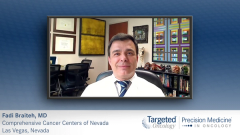
Mutations in GIST
An overview of mutations in gastrointestinal stromal tumor (GIST) and how they can influence treatment selection.
Brian Van Tine, MD, PhD: Fadi, I’d like to work through the mutations we see in patients and how we would approach them in the metastatic setting. In terms of adjuvant therapy, knowing what you’re treating, knowing what you’re committing somebody so is important. In the metastatic setting, it’s so much more complicated now that we have 2 more drugs. We actually have 3 more drugs, if you think of adding NTRK inhibitors to this very complex schematic. This is no longer imatinib, sunitinib, regorafenib, and then we’re done. This is something where you actually have to know what you’re treating. So if we go with the classic mutations, which revolve around exon 11, how do you classically approach them?
Fadi Braiteh, MD: Again, this carries on our recommendation for molecular profiling early on in metastatic disease. Even if you tested, maybe 5 years ago, a resected lesion and came back, look at the technology that we used. Was it comprehensive testing? Maybe they didn’t include evaluation for NTRK or other mutations, and you think there is no c-KIT mutation or PDGFRA mutation. So it’s very important to know what you already tested with and know what gene has been interrogated in a panel, if it was historical.
If it is your most common exon 11 mutation, or it’s one of the exon 9 mutations, statistically these are the ones you’re going to get with a c-KIT mutation. But, others are still possible. If I know it is a c-KIT wild-type patient, I’m comfortable, personally, bypassing going the imatinib, sunitinib, regorafenib path sequence. Remember, again, that even with imatinib as frontline therapy, we’re not curing patients. We’re having disease control, on average, for a year and a half before the disease progresses. I’ll need to reinterrogate the tumor. If it’s an early progressor or someone who has been treated without knowing what mutation they have, it puts pressure on the treating physician or tertiary center, definitely, to reinterrogate the tumor and know what mutation is driving this. Is this something for which a higher dose of imatinib—800 mg—is warranted if tolerated? Or we may want to bypass the whole c-KIT inhibitor paradigm. If a NTRK rearrangement is detected, I would start with one of the 2 NTRK inhibitors.
Brian Van Tine, MD, PhD: I absolutely agree. This is more of a sarcoma doctor’s “what would you do” question: What if they’re exon 9? What do you start with?
Fadi Braiteh, MD: Based on the data,I would like to start with 800 mg of imatinib. Some people may say, “I may bypass that. I’m not sure.” Outside of a tertiary center, I have not seen anybody going outside of using imatinib at 800 mg, although there are data. Maybe you would bypass that.
Brian Van Tine, MD, PhD: Actually, for tolerance reasons, 400 mg does work in a lot of patients. I start there before I go up. The 800-mg dose is very hard to tolerate. If we look at exon 11, exon 9, sunitinib is a much better drug. But we still consider the paradigm of the published data, which is to start with imatinib. If you then go through and say, “We’ve looked at exon 11, exon 9,” the next thing that pops up that we used to do nothing for is D842V. D842V-mutated GIST [gastrointestinal stromal tumor] was a surgical tumor, until recently. I think one of the most interesting things that comes out of the trial for avapritinib is there is now a drug for this disease. I think this was transformative because if you look at the data, there was a response.
Transcript edited for clarity.















































